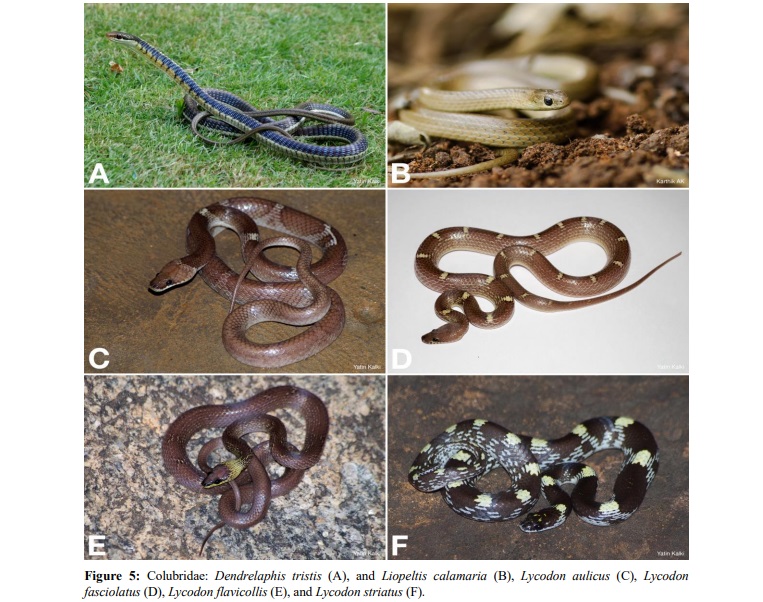Articles

Journal Article June 2021
Systematic and thorough studies of snake populations across large areas are rare in the tropics. Bengaluru city in southern India has not had a thorough checklist of snakes in over a century, during which time land-use changes, taxonomic revisions, and fluctuating reptile populations have left the current status of snakes of this region unclear. We combine data from snake rescues, visual encounter surveys, and other reliable records to generate a contemporary checklist of 33 snake species (15 of which are novel) present within the Bengaluru Urban District with comments on their apparent habitat preferences. We also provide evidence and insight on six additional species that have not been recorded but potentially occur within the limits of the district. Compared with the earlier checklist, all but 4 species (Naja naja, Ptyas mucosa, Daboia russelii, and Fowlea piscator) have shown considerable decline within city limits. Additionally, all of India's "Big Four" medically significant venomous snake species (Naja naja, Bungarus caeruleus, Daboia russelii, and Echis carinatus) are found within the district. Naja naja and Daboia russelii appear to be well-adjusted to urbanization with serious ramifications for human-wildlife conflict and healthcare in the future as the majority of Indian snakebite deaths can be attributed to these two species. The population trajectory of Daboia russelii is of particular interest as it was classified as "not common" in the previous checklist, but it is presently one of the most abundant snake species in the area. Our study provides a new baseline that can be used to monitor ophidian population trends going forward.
Karthik A. K. Sundaram
Annotated checklist of the snakes of Bengaluru Urban District, Karnataka, India with notes on their natural history, distribution, and population trends over the last 150 yearsSystematic and thorough studies of snake populations across large areas are rare in the tropics. Bengaluru city in southern India has not had a thorough checklist of snakes in over a century, during which time land-use changes, taxonomic revisions, and fluctuating reptile populations have left the current status of snakes of this region unclear. We combine data from snake rescues, visual encounter surveys, and other reliable records to generate a contemporary checklist of 33 snake species (15 of which are novel) present within the Bengaluru Urban District with comments on their apparent habitat preferences. We also provide evidence and insight on six additional species that have not been recorded but potentially occur within the limits of the district. Compared with the earlier checklist, all but 4 species (Naja naja, Ptyas mucosa, Daboia russelii, and Fowlea piscator) have shown considerable decline within city limits. Additionally, all of India's "Big Four" medically significant venomous snake species (Naja naja, Bungarus caeruleus, Daboia russelii, and Echis carinatus) are found within the district. Naja naja and Daboia russelii appear to be well-adjusted to urbanization with serious ramifications for human-wildlife conflict and healthcare in the future as the majority of Indian snakebite deaths can be attributed to these two species. The population trajectory of Daboia russelii is of particular interest as it was classified as "not common" in the previous checklist, but it is presently one of the most abundant snake species in the area. Our study provides a new baseline that can be used to monitor ophidian population trends going forward.

Journal Article September 2021
Abstract- Bandipur Tiger Reserve is one of the first wildlife reserves in India to adopt Project Tiger in 1974. It is known worldwide for its magnificent faunal species. This Park is located in the Indian state of Karnataka, The Park spans an area of 913.04 square kilometers. The Park is part of the Nilgiri Biosphere Reserve and is famous for its significant tiger and elephant population along with sandalwood trees. Karnataka has the second highest tiger population in India also protecting several species of India's endangered wildlife. During recent years, this park has had incidents of repeated fires. During 2019, this park has witnessed massive forest fires which resulted in huge loss of vegetation and life forms. This research paper aims to identify the fire prone areas by integrating vegetation type, past history of forest fire occurrence, road network and human activity. The temporal satellite data from 2009 to 2019 have been analyzed to map the Forest fire areas using Geographical Information System (GIS) and Remote Sensing (RS) techniques. The areas of the forest which were most prone to fire in these ten years are identified by analyzing the causes for fire incidents in the park.
Tejaswini J. S
Identifying the decadal forest fire effects on conversion of forest cover to grassland in Bandipur Tiger Reserve through geospatial technology.Abstract- Bandipur Tiger Reserve is one of the first wildlife reserves in India to adopt Project Tiger in 1974. It is known worldwide for its magnificent faunal species. This Park is located in the Indian state of Karnataka, The Park spans an area of 913.04 square kilometers. The Park is part of the Nilgiri Biosphere Reserve and is famous for its significant tiger and elephant population along with sandalwood trees. Karnataka has the second highest tiger population in India also protecting several species of India's endangered wildlife. During recent years, this park has had incidents of repeated fires. During 2019, this park has witnessed massive forest fires which resulted in huge loss of vegetation and life forms. This research paper aims to identify the fire prone areas by integrating vegetation type, past history of forest fire occurrence, road network and human activity. The temporal satellite data from 2009 to 2019 have been analyzed to map the Forest fire areas using Geographical Information System (GIS) and Remote Sensing (RS) techniques. The areas of the forest which were most prone to fire in these ten years are identified by analyzing the causes for fire incidents in the park.